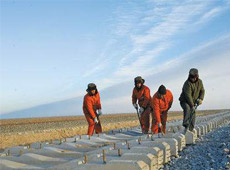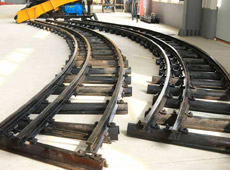


Responsibilty contributes to value



Sleepersspacing is one of the important parameters in designing track structure to a certain extent. The sleeperspacing is related to the number of railway sleepers laid per kilometer. The number of train track sleepers laid per kilometer should be determined according to the traffic volume, axle load, running speed and condition of track equipment, and should be combined with the main components of rails and ballast. In order to ensure sufficient strength and stability of the track under the most economical conditions, it should be matched rationally.
The distance between concrete sleepers is smaller, and the force on each part of the track can be smaller when it is in use. To a certain extent, the distance and direction of the sleeper can be easily maintained, which is particularly important for the high speed section. But the spacing should not be too small, too small, the number of sleepers laid is too many and uneconomical, and the spacing is too small, will also affect the tamping quality to a certain extent. On the main line of the existing line, the line standard has been improved, and the number of concrete sleepers per kilometer is the same as that of wooden sleepers.
Requirements for the Use of Railway Sleepers Spacing
1. The concrete sleeper track is in the curve section (including transition curve and circular curve) whose radius is 800m or less than that.
2. The sleeper track or electric traction line is in the curve section with radius of 800m or less than that.
3. The downhill area larger than 12;
4. Tunnels with length greater than or equal to 300 m and wooden sleepers.
The sleepers have a wide range of materials, the same specifications, uniform elasticity, good insulation and high stability. It is not affected by weather, temperature and other external conditions, and has a long service life. Sleepers need steam stripping once forming, smooth appearance, hard inside, and contain multiple threaded steel.
Safety Rules for Handling Sleepers
1. Vehicles with fixed frames should be used in sleeper highway transportation. Transport vehicles should be suitable for sleeper size. The number of loading layers should be no more than 6 layers. After loading, they should be firmly tied up to prevent displacement during transportation.
2. Hardwood railway sleepers transportation shall be loaded in accordance with the loading scheme approved by the railway department.
3. When loading, two triangular wedges are plugged between each pile of sleepers to prevent collision and damage during sleeper transportation.
4. Railway sleepers should be carried in accordance with the following provisions: (1) four people should be used to lift concrete sleepers; more people should be used to carry bridge crossties, fork crossties, etc. (2) When lifting crossties, the sleepers should be firm, the lifting should be smooth and the pace should be the same when placed.
- South of Changjiang village in Mishan town, Wendeng district, Weihai city of Shandong, PRC
- sales@chinasleepers.com
- +86-15256911480




-
Los Angeles Subway Renovation Project
In May of 2018, Ruihe plant started a business with SCJV from USA on the project of LA subway project. Ruihe is the only manufacturer to get the certificate of AC 157F-485 issued International Accredi......
-
Argentina Belgrano Freight Railway Renovation Project
In July of 2015, Argentina representatives for Belgrano freight railway project came to visit Weihai Ruihe Railway Sleeper Co.,Ltd, and appointed Ruihe as the sole manufacturer of this project.With in...
-
Reconstruction Project for Belgrano Freight Railway in Argentina
Weihai Ruihe Railway Sleeper Co., has participated the 1st phase of reconstruction project for Belgrano freight railway in Argentina. Our sleeper products have successfully passed the Acceptance and s...
-
Testing ties manufactured by Ruihe have passed all the qualification tests, and meet the needs of American customers. In December of 2018, Ruihe has been informed to conduct batch production.Figure be...
- South of Changjiang village in Mishan town
- sales@chinasleepers.com
- +86-15256911480














